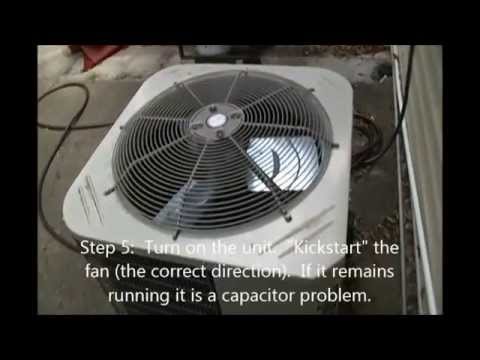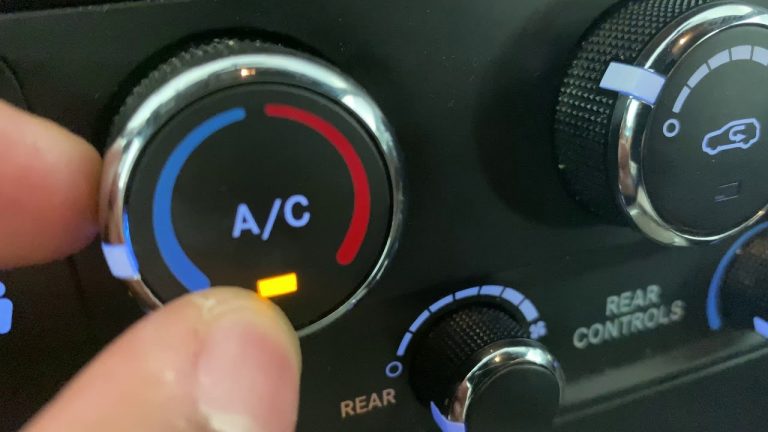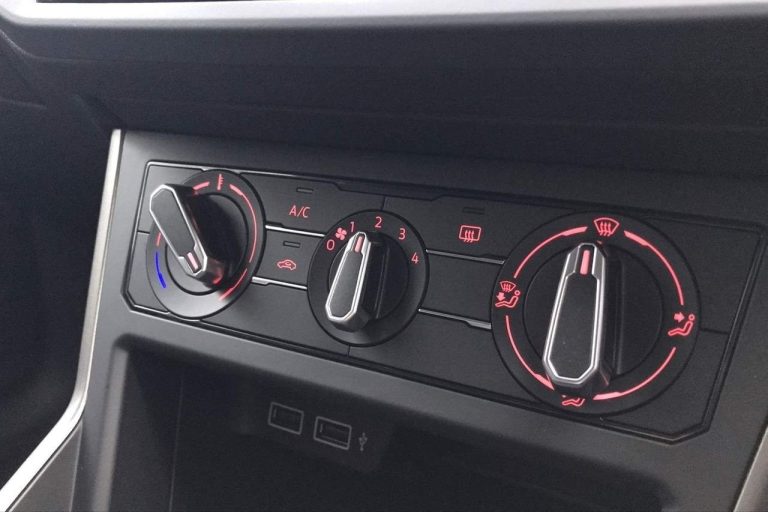How Cold Should My Ac Blow? Tips To Optimize Cooling Efficiency
The optimal temperature for your AC to blow depends on personal preference and comfort. Generally, setting the AC between 72-78 degrees Fahrenheit (22-26 degrees Celsius) during hot weather is recommended. However, it’s essential to find a balance that keeps you cool without feeling too cold or causing discomfort. Adjust the temperature according to your needs and consider energy efficiency and system lifespan as well.
Imagine walking into a room on a scorching summer day, eagerly anticipating a refreshing blast of cool air from your AC. But as you stand there, you realize that something is off.
The air feels too cold, almost bone-chilling, or maybe it’s barely noticeable, leaving you in a sweaty haze. Frustrating, isn’t it? That’s why understanding the optimal cooling efficiency of your AC is crucial.
In this article, we will explore the ins and outs of the question on every homeowner’s mind: How cold should my AC blow? Beyond providing a comfortable escape from the sweltering heat, finding the perfect balance ensures efficient energy use and a longer lifespan for your cooling system. Whether you’re a technologically inclined connoisseur or a newcomer to HVAC systems, these tips will empower you to take control of your indoor climate, maximizing both comfort and cost-effectiveness. So, let’s delve into the world of cooling efficiency and discover how to optimize your AC’s performance.
I. Understanding the Ideal Temperature Range for AC Operation
Setting the right temperature on your AC is vital for optimal comfort and energy efficiency. Keeping the room at an ideal temperature not only ensures a pleasant environment but also saves on energy costs. Let’s explore the factors to consider when determining the ideal temperature.
A. Importance of setting the right temperature
The right temperature setting plays a significant role in creating a comfortable indoor environment. It affects our overall well-being, productivity, and quality of sleep. Additionally, setting the AC to the correct temperature helps maintain consistent humidity levels, prevents mold growth, and reduces the strain on the cooling system.
B. Factors to consider when determining the ideal temperature
Several factors come into play when deciding the ideal temperature for your AC.
- Climate conditions: The climate in your region will heavily influence the ideal temperature setting. Warmer climates may require lower temperature settings to combat the heat, while cooler regions may need slightly higher settings.
- Insulation and building materials: The insulation in your home, along with the type of building materials used, can impact the indoor temperature. Well-insulated houses retain cool air better, allowing you to set a higher temperature.
- Personal preferences: Individual comfort levels vary, so it’s essential to consider personal preferences when determining the ideal temperature. Some people prefer a cooler environment, while others are comfortable with slightly higher temperatures.
- Energy efficiency considerations: Striking a balance between comfort and energy efficiency is crucial. Setting the temperature slightly higher can help reduce energy consumption and lower your utility bills.
II. The Science Behind Air Conditioning
Before diving into the specifics of temperature settings, let’s take a moment to understand how air conditioning works and the role temperature plays in its operation.
A. How air conditioning works
Air conditioning systems work by removing heat and moisture from the air, creating a cool and comfortable indoor environment. They consist of components like compressors, condensers, evaporators, and refrigerant chemicals.
When you adjust the thermostat to a specific temperature, it triggers the cooling cycle. The compressor compresses the refrigerant, raising its temperature. The hot refrigerant then flows through the condenser coils, where it releases heat to the outdoor environment.
After losing heat, the refrigerant enters the evaporator coils, causing the temperature to drop significantly. As warm air from the room passes over the cold coils, moisture condenses, and the air gets cooled. The cool air is then blown back into the room, while the warm refrigerant returns to the compressor to repeat the cycle.
B. Role of temperature in AC operation
The temperature setting on your AC controls the duration and frequency of the cooling cycle. The system will continue to run until the desired temperature is reached, after which it will cycle on and off to maintain that temperature.
When the AC runs longer, it removes more heat and moisture from the air, resulting in colder air. On the other hand, if the temperature setting is too low, the AC may cycle too frequently, leading to energy wastage and unnecessary wear and tear on the system.
C. Relationship between temperature and comfort
The perception of comfort varies from person to person. Several factors influence how we feel at a given temperature, including humidity, air movement, and individual preferences.
While a lower temperature may seem comforting on a hot day, a setting that is too cold can lead to discomfort and even health issues. It’s essential to find the right balance between cooling and comfort to create an environment that suits you.
III. Determining the Optimal AC Temperature for Different Environments
The ideal temperature settings for AC can vary depending on the environment. Whether it’s a residential home or a commercial space, different factors come into play.
A. Residential environments
In a residential setting, the ideal temperature for your AC will depend on various factors.
1. Recommended temperature range for homes
The U.S. Department of Energy recommends setting your thermostat to 78°F (25.5°C) during the summer months for optimal energy efficiency and comfort. However, personal preferences and regional climate conditions can influence this recommendation.
2. Factors affecting the ideal temperature for homes
When determining the ideal temperature for your home, consider the following factors:
- Climate conditions: Hotter climates may necessitate lower temperature settings, while cooler climates might allow for slightly higher settings.
- Insulation and building materials: Well-insulated homes with energy-efficient materials can retain cool air, allowing you to set the temperature higher.
- Personal preferences: Some individuals may prefer a cooler indoor environment, while others are comfortable with slightly higher temperatures.
- Energy efficiency considerations: Setting the temperature slightly higher can help save energy and reduce monthly utility bills.
By considering these factors, you can strike a balance between comfort and energy efficiency in your residential space.
B. Commercial environments
Commercial spaces, such as offices, retail stores, and restaurants, have their own unique considerations when it comes to AC temperature settings.
1. Recommended temperature range for offices, retail spaces, etc.
The American Society of Heating, Refrigerating and Air-Conditioning Engineers (ASHRAE) recommends setting the temperature in commercial buildings between 74-78°F (23-26°C) for offices and retail spaces. However, specific requirements may vary based on the industry and the nature of the business.
2. Factors influencing the ideal temperature in commercial settings
Determining the ideal temperature in commercial settings involves considering several factors:
- Occupancy levels: The number of people in a commercial space affects the temperature requirements. Higher occupancy levels may require cooler settings to maintain comfort.
- Type of business or industry: Certain industries, such as restaurants or data centers, have specific temperature requirements. Compliance with industry standards is essential to ensure proper functioning and customer satisfaction.
- Employee comfort and productivity: Ensuring a comfortable working environment is crucial for employee morale and productivity. Setting the temperature at a level that promotes productivity and comfort is essential.
- Customer satisfaction: For businesses that serve customers, maintaining a comfortable environment is essential for customer satisfaction and repeat business.
Considering these factors will help determine the ideal temperature settings for commercial environments.
IV. Effects of Setting the AC Temperature Too Low
While a lower AC temperature can provide immediate relief from the heat, there are potential drawbacks to consider.
A. Energy consumption
1. Impact on monthly electricity bills:
Setting the AC temperature too low can significantly increase energy consumption. The cooling system has to work harder and run for longer periods to maintain the low temperature, resulting in higher electricity bills.
2. Environmental considerations:
Increased energy consumption not only impacts your wallet but also contributes to higher carbon emissions. By setting the temperature at a slightly higher level, you can reduce your carbon footprint and help preserve the environment.
B. Health and comfort issues
1. Potential for discomfort and cold-related health problems:
Setting the AC temperature too low can lead to discomfort, especially if the temperature difference between the indoor and outdoor environments is significant. It can result in cold-related health issues such as headaches, dry skin, and even hypothermia in extreme cases.
2. Effects on the respiratory system:
Exposure to extremely cold air can have negative effects on the respiratory system. It can cause airway constriction, irritation, and aggravate conditions such as asthma and allergies.
3. Allergies and humidity control:
Very low temperatures can lead to excessively dry air, which can aggravate allergies and respiratory conditions. Additionally, inadequate humidity control can promote the growth of allergens such as dust mites and mold.
V. Effects of Setting the AC Temperature Too High
While setting the AC temperature too low can have its drawbacks, setting it too high also comes with its own set of issues.
A. Inadequate cooling
1. Impact on comfort levels:
Setting the AC temperature too high may result in inadequate cooling, especially on extremely hot days. It can leave you feeling uncomfortable and unable to escape from the heat.
2. Potential for heat-related health issues:
Exposure to high temperatures for an extended period can lead to heat-related health problems such as heat exhaustion or heat stroke. It’s crucial to strike a balance between comfort and avoiding the risk of heat-related illnesses.
B. Increased humidity
1. Moisture control and mold growth:
Higher temperatures combined with increased humidity can create a breeding ground for mold. Mold growth not only damages property but can also lead to health issues such as allergies and respiratory problems.
VI. Optimizing AC Temperature for Energy Efficiency
Striking a balance between comfort and energy efficiency is essential to optimize AC temperature settings.
A. The concept of Set Point Temperature
The set point temperature refers to the desired temperature at which the AC system aims to maintain the room. By setting an appropriate set point temperature, you can avoid excessive energy consumption and enhance comfort.
B. Tips for balancing comfort and energy savings
1. Utilizing programmable thermostats:
Programmable thermostats allow you to set different temperature schedules throughout the day. By adjusting the temperature settings based on occupancy levels, you can save on energy costs while still maintaining comfort.
2. Utilizing zoning systems in larger spaces:
If you have a larger space or multiple rooms, consider utilizing zoning systems. Zoning allows you to set different temperature zones, enabling you to cool only the areas that are occupied, reducing energy wastage.
3. Using fans and natural ventilation:
Supplementing your AC with fans and natural ventilation can help circulate the cool air better. Fans create a wind-chill effect, making you feel cooler without significantly reducing the temperature setting on your AC.
VII. Adjusting the AC Temperature for Different Times of the Day
Adjusting the AC temperature based on the time of day can further enhance energy efficiency and comfort.
A. Nighttime temperature settings for better sleep
At night, when the outdoor temperature drops, you can increase the temperature setting on your AC. This allows you to save energy while still maintaining a comfortable sleeping environment. Additionally, using fans or opening windows can provide natural ventilation and cooling during cooler nights.
B. Temperature adjustments during periods of absence
When you’re away from home or not using specific rooms for an extended period, consider increasing the temperature setting on your AC. This helps conserve energy while ensuring that the space doesn’t become excessively hot or humid.
VIII. Proper AC Maintenance for Optimal Cooling
Regular maintenance of your AC system is crucial for its optimal performance and cooling efficiency.
A. Regular filter cleaning or replacement
Clean or replace your AC filters regularly to ensure proper airflow and prevent dust and debris buildup. Clogged filters can reduce cooling efficiency and strain the system, leading to higher energy consumption.
B. Routine professional inspections and maintenance
Schedule routine maintenance visits with a professional HVAC technician. Regular inspections and maintenance can identify and address any issues before they escalate, ensuring that your AC operates at peak performance.
C. Ductwork inspection and insulation
Have your ductwork inspected to ensure proper insulation and seal any leaks. Leaky ducts can cause cool air to escape, reducing cooling efficiency and increasing energy consumption.
IX. Conclusion
Finding the optimal temperature for your AC is crucial for both comfort and energy efficiency. By understanding the factors that influence temperature settings, you can create a pleasant indoor environment while minimizing energy consumption.
Remember to consider climate conditions, insulation, personal preferences, and energy efficiency when determining the ideal temperature. Regular maintenance and adjustments based on occupancy and time of day further enhance cooling efficiency.
Optimizing your AC temperature not only provides a comfortable escape from the summer heat but also contributes to a healthier environment and lower energy bills. So go ahead, find that perfect balance, and enjoy the benefits of an efficiently cooled space.
Doing This Will Make Your Car’s AC Blow Twice as Cold
Frequently Asked Questions (FAQ)
How cold should my AC blow?
Why is my AC blowing warm air?
Can I set my AC to blow colder air?
Should I set my AC to blow at its maximum capacity?
Why is my AC blowing too cold?
Final Summary: The Importance of Setting the Right Temperature for Your AC
In conclusion, setting the right temperature for your AC is important for comfort and energy efficiency. Factors such as climate conditions, insulation, personal preferences, and energy efficiency considerations should be taken into account when determining the ideal temperature.
It is recommended to set the thermostat to 78°F (25.5°C) in residential homes during the summer months for optimal energy efficiency.
For commercial spaces, the recommended temperature range is between 74-78°F (23-26°C), although specific requirements may vary based on the industry and type of business. Setting the AC temperature too low can increase energy consumption, contribute to higher carbon emissions, and lead to health and comfort issues such as dry skin and respiratory problems. On the other hand, setting the temperature too high can result in inadequate cooling, heat-related health issues, and increased humidity, which promotes mold growth.
To optimize energy efficiency, it is important to strike a balance between comfort and savings. Utilizing programmable thermostats, zoning systems, fans, and natural ventilation can help achieve this balance. It is also recommended to adjust the AC temperature based on the time of day, such as increasing the temperature at night and during periods of absence.






